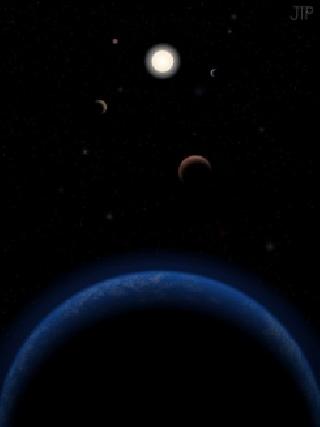
An artist's impression of the Tau Ceti system. Photo by J. Pinfield for the RoPACS network at the University of Hertfordshire
SANTA CRUZ, CALIFORNIA (BNS): A Sun-like star lying at a distance of just 12 light years from Earth could be hosting five planets, including one in its habitable zone, a team of international astronomers has found.
Tau Ceti, one of the closest and most Sun-like stars visible to naked eye in the evening sky, has the same spectral classification as our Sun.
The star could be hosting a planetary system, according to the team of astronomers from UK, Chile, US, and Australia, who combined more than six-thousand observations from three different instruments and intensively modeled the data.
The five planets around Tau Ceti are estimated to have masses between two and six times the mass of the Earth, making it the lowest-mass planetary system yet detected.
One of the planets lies in the habitable zone of the star and has a mass around five times that of Earth, making it the smallest planet found to be orbiting in the habitable zone of any Sun-like star.
"This discovery is in keeping with our emerging view that virtually every star has planets, and that the galaxy must have many such potentially habitable Earth-sized planets," said co-author Steve Vogt, a professor of astronomy and astrophysics at the University of California, Santa Cruz.
"We are now beginning to understand that nature seems to overwhelmingly prefer systems that have multiple planets with orbits of less than 100 days. This is quite unlike our own solar system, where there is nothing with an orbit inside that of Mercury. So our solar system is, in some sense, a bit of a freak and not the most typical kind of system that Nature cooks up."
Over 800 planets have been discovered orbiting other worlds, but planets in orbit around the nearest Sun-like stars are particularly valuable.
"Tau Ceti is one of our nearest cosmic neighbours and so bright that we may be able to study the atmospheres of these planets in the not-too-distant future. Planetary systems found around nearby stars close to our Sun indicate that these systems are common in our Milky Way galaxy," said James Jenkins of Universidad de Chile, a visiting fellow at the University of Hertfordshire.
The researchers used data from three state-of-the-art spectrographs: HARPS on the 3.6-meter telescope at the European Southern Observatory in La Silla, Chile; UCLES on the Anglo-Australian Telescope in Siding Spring, Australia; and HIRES on the 10-meter Keck telescope on Mauna Kea, Hawaii.
The team's findings appear in the journal Astronomy & Astrophysics.
 Previous Article
Previous Article Next Article
Next Article













The Indian Air Force, in its flight trials evaluation report submitted before the Defence Ministry l..
view articleAn insight into the Medium Multi-Role Combat Aircraft competition...
view articleSky enthusiasts can now spot the International Space Station (ISS) commanded by Indian-American astr..
view article